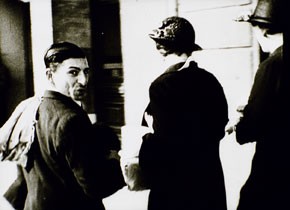Film. City. Vienna
Three Afternoons
January 17, 24 and 31, 2010
In 1914, the early urban sociologist Robert Ezra Park remarked that “the city is a state of mind.” By that time, the modern city had already transformed itself into something more than a concrete physical environment: its built space had become deeply intertwined with a specific set of sensations and thoughts, and with manifold forms of expression and aesthetic experience. These “un-built” characteristics of city life turn the metropolis into a mutable mental space. Since the late 19th century, the cinema has played a crucial role in this process.
At the start of a new Research project – and in conjunction with a major exhibition about Vienna in the 1920s and 30s – the Film Museum presents three extensive afternoon programs devoted to the relationship between film and the city. The first program, The Cinematic Metropolis (Jan 17) introduces a series of canonical “city films” shot in Paris, Berlin, New York, Prague, Chicago and Amsterdam, ranging from early Lumière and Edison “views” to works by artists such as Henri Chomette, Alexander Hackenschmied, Joris Ivens, Jay Leyda, László Moholy-Nagy, and Walter Ruttmann.
The other two presentations focus on Vienna, unearthing many rare film documents from the Film Museum’s collection. These “orphans” of film history are also the main focus of the new research project. Program 2, The Fordist City (Jan 24), tackles the themes of advertising and industrial films, as well as chronicles of sporting events and political rallies of the First Austrian Republic. Program 3, Home Movie City (Jan 31) covers terrain not often explored by film museums: Viennese amateur films from the 1920s through the 1940s document a private (or semi-professional) form of “forensics” and allow remarkable insight into Viennese lifestyles, attitudes and approaches to the city – as private memory replaces official historiography.
The exhibition “Struggle for the city – Politics, arts and urban life around 1930” is on view at the Vienna Künstlerhaus until March 28, 2010. The research Project Film.City.Vienna is a collaboration between the Ludwig Boltzmann Institute for History and Society, D & S (Gustav Deutsch & Hanna Schimek) and the Austrian Film Museum, with funding from WWTF.
Related materials
Link StadtFilmWien


